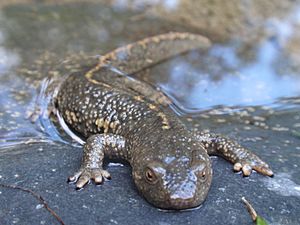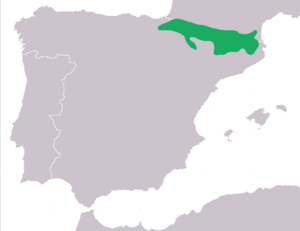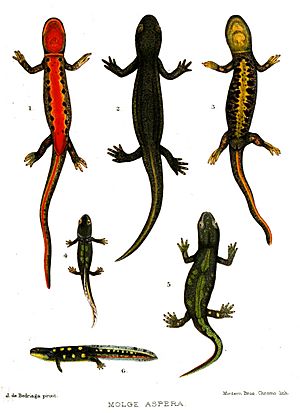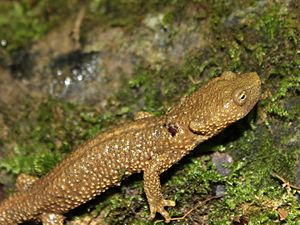Pyrenean brook salamander facts for kids
Quick facts for kids Pyrenean brook salamander |
|
|---|---|
 |
|
| Conservation status | |
| Scientific classification | |
| Genus: |
Calotriton
|
| Species: |
asper
|
 |
|
| Synonyms | |
|
|
The Pyrenean brook salamander or Pyrenean newt (Calotriton asper) is a type of salamander that mostly lives in water. It belongs to the Salamandridae family. You can find this animal in the Pyrenees mountains, which stretch across Andorra, France, and Spain. Scientists who study animals say it is not currently in danger of disappearing.
Contents
What Does the Pyrenean Newt Look Like?
The Pyrenean brook salamander can grow to about 16 cm (6.3 in) long. Half of this length is its tail, which is flat on the sides. Female salamanders are usually bigger than males.
This salamander has a strong body with a flat head and small eyes. Its legs are short. Its skin feels rough because it's covered with tiny bumps. The color of these salamanders can be very different. Their top side is often olive, grey, dark grey, or muddy brown. Sometimes, they have yellow spots or a yellow stripe down their back.
The underside of the salamander has dark spots on each side. The middle part is usually red, orange, or yellow. Males and females have slightly different shapes in a certain area near their tail.
Where Do Pyrenean Newts Live?
The Pyrenean brook salamander is only found in the Pyrenees mountains and the hills nearby. It lives high up in the mountains, from about 700 to 2,500 metres (2,300 to 8,200 ft) above sea level.
These newts mostly live in water. They prefer slow-moving streams and shallow mountain lakes. They like water that is cooler than 15 °C (59 °F). They also like places with rocky or pebbly bottoms and not many plants. Some Pyrenean brook salamanders even live entirely inside caves. In caves, they can have babies all year long because there's no sunlight to tell them what season it is.
Pyrenean Newt Behavior and Diet
The Pyrenean brook salamander is not seen very often, even though it is active both during the day and at night. In the summer, it spends most of its time in the water.
These newts eat insects and other small, slow-moving invertebrates like worms. Bigger fish, like trout, sometimes eat the salamanders. So, you might not find many Pyrenean newts in places where there are lots of trout. These salamanders are also sensitive to pollution in the water, which can make them sick.
Life Cycle and Reproduction
When the weather gets very hot in the lower parts of its home, the Pyrenean brook salamander might take a long nap. This is called aestivation. In winter, at higher altitudes, it sleeps on land. It comes out again in the spring.
When it's time to find a mate, the male shows off his bright belly colors. He then holds the female with his tail and passes on what's needed to make babies. This can take several hours.
The female lays about 20 to 40 eggs over a few weeks. She sticks them to rocks or hides them in cracks using a special part of her body. The eggs hatch after about six weeks. The baby salamanders, called larvae, have gills on the outside of their bodies and eat only meat. They might spend one or more winters as larvae before they change into adult salamanders. They become fully grown in two or more years, depending on how high up in the mountains they live. Females take a bit longer to mature. Young newts are dark in color with a thin, yellow line down their back.
See also
 In Spanish: Tritón pirenaico para niños
In Spanish: Tritón pirenaico para niños




